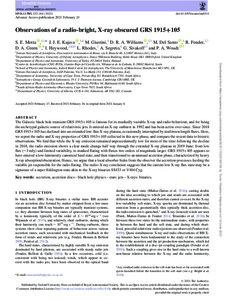Observations of a radio-bright, X-ray obscured GRS 1915+105
Del Santo M; Sivakoff G; Heywood I; Segreto A; Giustini M; Rhodes L; Williams DRA; Kajava JJE; Woudt PA; Green DA; Motta SE; Fender R
Observations of a radio-bright, X-ray obscured GRS 1915+105
Del Santo M
Sivakoff G
Heywood I
Segreto A
Giustini M
Rhodes L
Williams DRA
Kajava JJE
Woudt PA
Green DA
Motta SE
Fender R
OXFORD UNIV PRESS
Julkaisun pysyvä osoite on:
https://urn.fi/URN:NBN:fi-fe2021093048614
https://urn.fi/URN:NBN:fi-fe2021093048614
Tiivistelmä
The Galactic black hole transient GRS 1915+105 is famous for its markedly variable X-ray and radio behaviour, and for being the archetypal galactic source of relativistic jets. It entered an X-ray outburst in 1992 and has been active ever since. Since 2018 GRS 1915+105 has declined into an extended low-flux X-ray plateau, occasionally interrupted by multiwavelength flares. Here, we report the radio and X-ray properties of GRS 1915+105 collected in this new phase, and compare the recent data to historic observations. We find that while the X-ray emission remained unprecedentedly low for most of the time following the decline in 2018, the radio emission shows a clear mode change half way through the extended X-ray plateau in 2019 June: from low flux (similar to 3mJy) and limited variability, to marked flaring with fluxes two orders of magnitude larger. GRS 1915+105 appears to have entered a low-luminosity canonical hard state, and then transitioned to an unusual accretion phase, characterized by heavy X-ray absorption/obscuration. Hence, we argue that a local absorber hides from the observer the accretion processes feeding the variable jet responsible for the radio flaring. The radio-X-ray correlation suggests that the current low X-ray flux state may be a signature of a super-Eddington state akin to the X-ray binaries SS433 or V404 Cyg.
Kokoelmat
- Rinnakkaistallenteet [19207]
